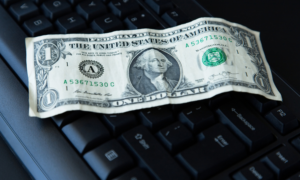

 I recently had the privilege of interviewing Rick Ferri, founder of Portfolio Solutions, an investment management firm in Troy, Michigan. Rick is the author of several excellent books on ETFs, index funds and passive investing, including one of my favourites, All About Asset Allocation (McGraw Hill, 2010), which has just been released in a second edition.
I recently had the privilege of interviewing Rick Ferri, founder of Portfolio Solutions, an investment management firm in Troy, Michigan. Rick is the author of several excellent books on ETFs, index funds and passive investing, including one of my favourites, All About Asset Allocation (McGraw Hill, 2010), which has just been released in a second edition.
One of the issues Ferri and I discussed was the outrageous popularity of investing in gold. SPDR Gold Shares (GLD) is now the second-largest largest ETF in the world, with more than $56 billion (US) in assets, something that would have been inconceivable five years ago. One of the most common reasons people give for buying gold is that it offers security in the event of financial or economic catastrophe. Here’s Ferri’s take on that logic:
“Everybody is putting their money into GLD. But it’s a piece of paper: they are not going to issue you gold bars. If the banking industry collapses, how are you going to get your gold? If Armageddon comes along you might say, ‘That’s OK, because I own gold.’ But you don’t own gold, you own GLD. I suppose you could go to the vault in London with your piece of paper and ask for your gold — assuming that airlines are still flying. Good luck with that.
“So you say you don’t trust the banking system, and the whole world is going to crap, you don’t trust anything except gold, but then you own GLD? Everything was fine up until the point where you said you own GLD.”
Would you invest in a pile of bricks?
Ferri went on to say that the whole concept of owning gold as a currency of last resort presumes that you own physical gold. But even then, he argues that gold and other commodities are not good long-term investments, comparing them to a pile of bricks:
“You can take a bunch of bricks and pile them in your backyard and look at them every day and say, ‘Go up in value, go up in value.’ But you can’t say, ‘What kind of dividends are my pile of bricks going to pay me this year?’ Because it’s zero. How much interest am I going to get from my pile of bricks? None. Is my pile of bricks going to become two piles of bricks over the next 10 years? No, it’s going to be one pile of bricks a year from now, 10 years from now, and a hundred years from now. You’re just hoping that someone comes along who thinks that pile of bricks is worth much more than you paid for it.
“I want to invest in things that have cash flow. That’s the bottom line. If I’m going to invest for the long term, and not just trade, then all of the asset classes I have are going to have cash flow. They are all going to pay either interest or dividends, or if it’s real estate they’re going to pay rent. With growth stocks, the idea is that they are going to pay dividends in the future. That’s investing: you invest for future cash flow.
“A pile of bricks has no cash flow. To include them in your portfolio, you would have to know something about the supply and demand for bricks. You would have to know that the market for bricks is going to change, and thus the future value of your pile of bricks is going to be more than it is now, even after adjusting for inflation. Unless you are a brick producer, I don’t know how you would know that — and I don’t even think the brick producers would know that. But everybody buying gold seems to know. They know that the economics are changing, and therefore the value of gold is going to be higher in the future. Even though 90% of these people have never owned an ounce of gold in their lives, all of a sudden they are experts on the supply and demand for gold.
“If I am going to have commodity exposure, I would rather own the companies that make money from commodities. Because the company can become more productive or more efficient. The company pays dividends. The company can make money even when the underlying commodity isn’t. There are times when gold does much better than gold mining stocks, but in the long run you’re much better off buying precious-metal mining stocks — and in Canada, you’ve already got that if you own a broad-market index fund.”

 I recently had the privilege of interviewing
I recently had the privilege of interviewing 









